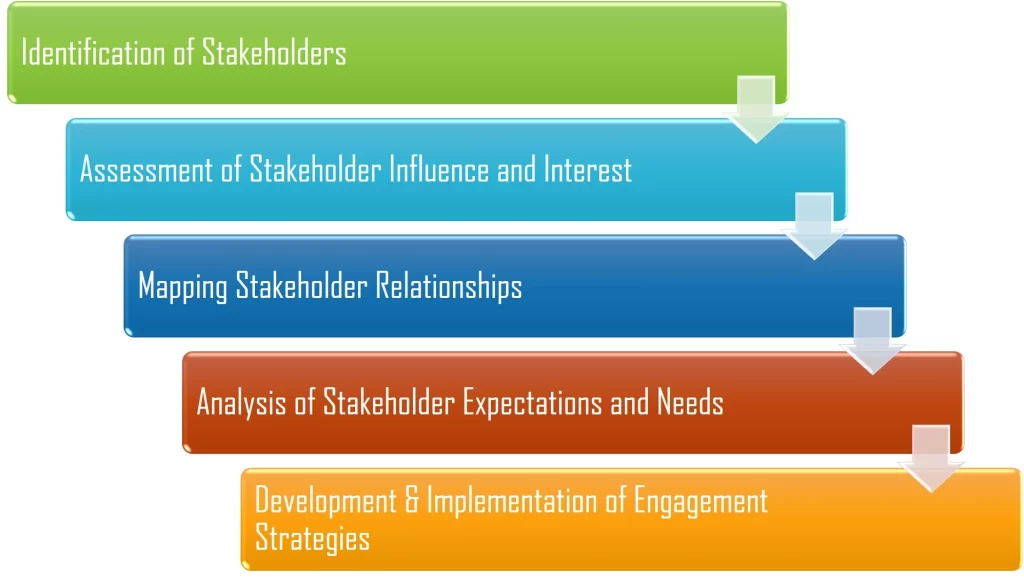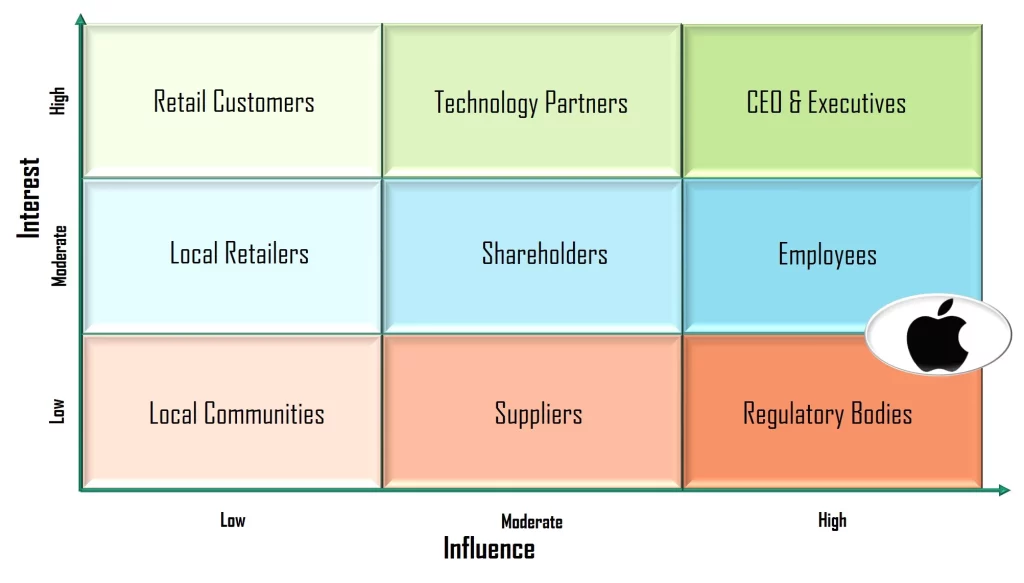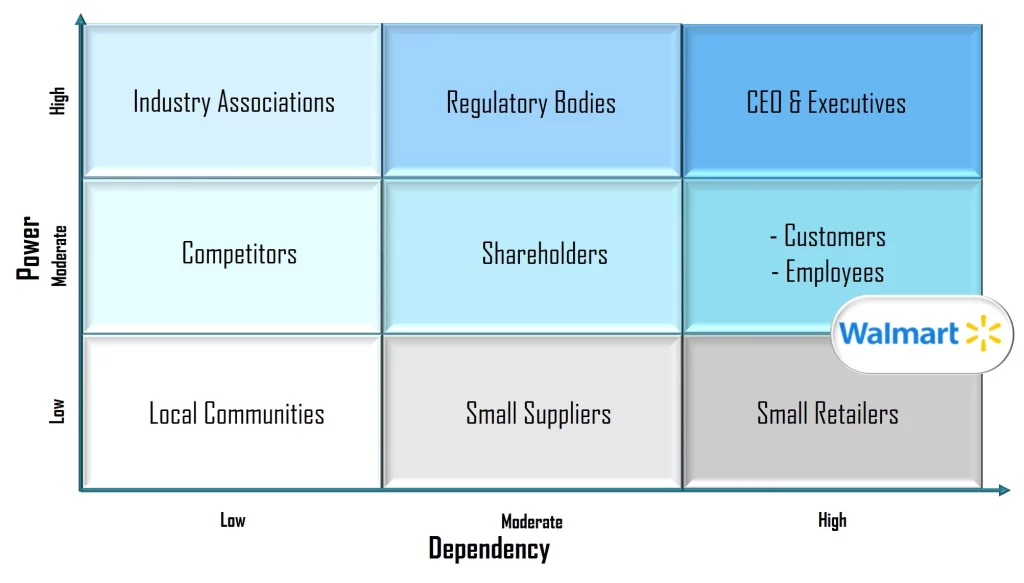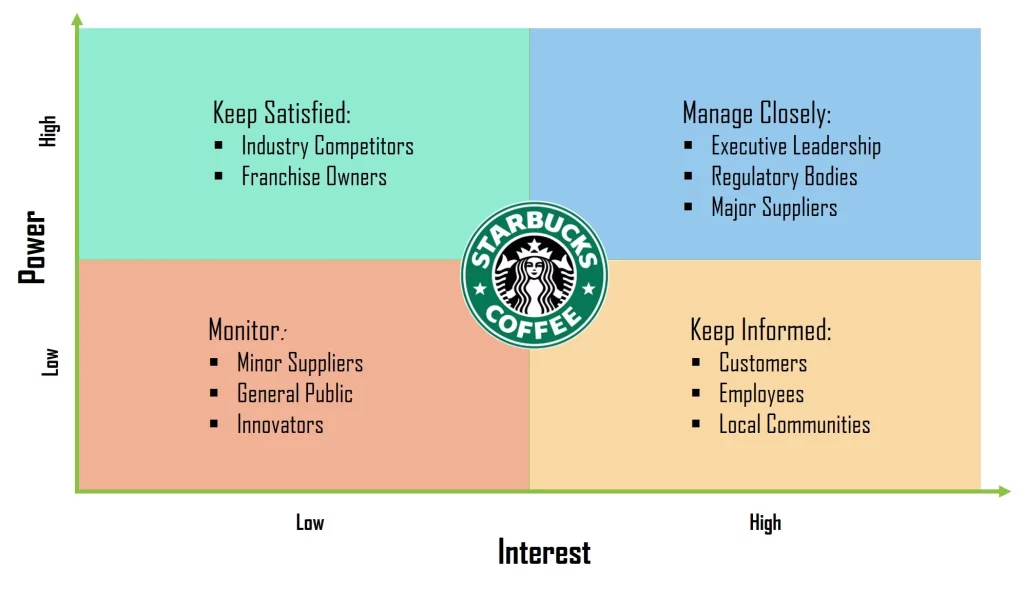 Stakeholder analysis is a systematic process of identifying, assessing, and managing the individuals, groups, or organizations that can significantly affect or be affected by a project, decision, or initiative. The purpose of stakeholder analysis is to understand the interests, expectations, and influence of various stakeholders to ensure that their concerns are taken into account and that effective communication and engagement strategies are developed.
Stakeholder analysis is a systematic process of identifying, assessing, and managing the individuals, groups, or organizations that can significantly affect or be affected by a project, decision, or initiative. The purpose of stakeholder analysis is to understand the interests, expectations, and influence of various stakeholders to ensure that their concerns are taken into account and that effective communication and engagement strategies are developed.
How to: Steps
- Identification of Stakeholders: This involves creating a comprehensive list of all individuals, groups, or organizations that may have an interest in or be impacted by the project.
- Assessment of Stakeholder Influence and Interest: Once identified, stakeholders are analyzed based on their level of influence and interest in the project. This helps prioritize engagement efforts and resources.
- Mapping Stakeholder Relationships: Understanding how different stakeholders relate to each other can provide insights into potential conflicts or alliances. Stakeholder mapping is a visual representation of these relationships.
- Analysis of Stakeholder Expectations and Needs: Assessing the expectations, needs, and concerns of each stakeholder group helps in tailoring communication and engagement strategies to address specific issues.
- Development of Engagement Strategies: Based on the analysis, organizations can develop targeted communication and engagement plans to involve stakeholders throughout the project lifecycle. This may include regular updates, consultations, or feedback mechanisms.
- Implementation of Engagement Activities: Actively engaging with stakeholders as per the devised strategies is crucial for building positive relationships, managing expectations, and addressing concerns in a timely manner.
Stakeholder analysis is a dynamic process that should be revisited and updated regularly, especially when there are significant changes in the project or its environment. It is a valuable tool for project managers, decision-makers, and organizations to ensure successful project implementation and minimize potential conflicts.
Tools & Techniques
- Stakeholder Identification Matrix:
- Power-Interest Grid:
- Salience Model:
- Stakeholder Mapping:
- SWOT Analysis (Strengths, Weaknesses, Opportunities, Threats):
- Interviews and Surveys:
- Document Review:
- Social Network Analysis:
- Brainstorming:
- Stakeholder Registers:
Using a combination of these tools and techniques can provide a comprehensive understanding of stakeholders and their impact on a project, facilitating effective communication and engagement strategies.
Common Stakeholders in Businesses
- Customers: Individuals or organizations that purchase and use the products or services offered by the business.
- Employees: The workforce of the business, including both management and staff.
- Shareholders/Owners: Individuals or entities that own shares or have ownership interests in the company.
- Investors: Individuals or institutions that provide financial capital to the business in exchange for returns on investment.
- Suppliers: Entities that provide goods, services, or raw materials necessary for the business’s operations.
- Government: Regulatory bodies, agencies, and government authorities that may impose laws, regulations, or policies affecting the business.
- Local Communities: Residents and community organizations in the areas where the business operates.
- Competitors: Other businesses operating in the same industry or market.
- Media: Journalists, editors, and media outlets that can influence the public perception of the business.
- Trade Unions: Organizations that represent the interests of employees and negotiate on their behalf regarding employment conditions.
- Non-Governmental Organizations (NGOs): Groups focused on social, environmental, or ethical issues that may have concerns about the business’s practices.
- Creditors: Entities or individuals that extend credit to the business, such as banks or other financial institutions.
- Industry Associations: Organizations representing the collective interests of businesses within a specific industry.
- Regulatory Bodies: Agencies responsible for overseeing and enforcing industry-specific regulations.
- Board of Directors: Individuals elected or appointed to represent the interests of shareholders and provide oversight to the management of the company.
Understanding and effectively managing relationships with these stakeholders is crucial for the success and sustainability of a business. Engaging with stakeholders, addressing their concerns, and considering their interests can contribute to a positive reputation and long-term success.
Examples
Apple Stakeholder Analysis:
Below is an example of a stakeholder analysis on Apple Inc. that applies the stakeholder mapping tool:

Walmart Stakeholder Analysis:
Below is an example of a stakeholder analysis on Walmart Inc. that applies the stakeholder mapping tool:
Starbucks Stakeholder Analysis:
Below is an example of a stakeholder analysis on Starbucks Corp. that applies the power-interest grid tool:
McDonald’s Stakeholder Analysis:
Below is an example of a stakeholder analysis on McDonalds Corp. that applies the power-interest grid tool:
FAQs
-
How do I identify the key stakeholders in a project or organization?
Identifying key stakeholders involves a systematic process:
- Stakeholder Identification: Begin by listing potential stakeholders. This includes individuals, groups, or organizations who may be affected by the project or can influence its outcomes.
- Stakeholder Analysis Tools: Utilize tools such as stakeholder matrices, brainstorming sessions, or stakeholder mapping to categorize and prioritize stakeholders based on their relevance, interest, and influence.
- Engagement from Different Perspectives: Seek input from various team members, departments, and external sources to ensure a comprehensive list that captures diverse perspectives.
- Review Documentation: Examine project documentation, organizational charts, and historical records to identify stakeholders involved in similar projects or initiatives.
- Stakeholder Surveys and Interviews: Directly engage with stakeholders through surveys, interviews, or focus groups to gather insights into their roles, expectations, and potential impact on the project.
-
How do I determine interests of each stakeholder in a project or organization?
- Conduct Stakeholder Interviews: Engage stakeholders in one-on-one or group interviews to directly inquire about their interests, concerns, and expectations related to the project.
- Analyze Communication Channels: Examine communication channels and materials relevant to stakeholders, such as official statements, press releases, or public statements, to understand expressed interests.
- Review Past Interactions: Analyze historical interactions and feedback to identify recurring themes or areas of interest expressed by stakeholders.
- Consider Organizational Objectives: Align stakeholder interests with the broader organizational objectives to identify common goals and potential areas of collaboration.
- Feedback Mechanisms: Establish feedback mechanisms, such as surveys or suggestion boxes, to gather ongoing insights into evolving stakeholder interests.
-
How do I determine how much influence or power each stakeholder has?
- Power Mapping: Utilize power mapping tools or frameworks to assess the formal and informal power structures within the organization and industry.
- Expert Opinions: Seek input from subject matter experts, leaders, or individuals with deep knowledge of the industry to gauge stakeholders’ influence.
- Evaluate Decision-Making Authority: Assess the decision-making authority held by each stakeholder, considering their roles and positions within the organization.
- Track Previous Impact: Review past projects or decisions to understand the impact that certain stakeholders had on outcomes.
- Consider Network Connections: Analyze the network connections and relationships between stakeholders, as influential connections can enhance overall influence.
-
How do I determine the level of support or opposition from each stakeholder?
- Stakeholder Surveys: Implement stakeholder surveys to directly ask about their level of support, concerns, or opposition to the project.
- Analyze Communication Tone: Assess the tone and content of communication from stakeholders to gauge their stance, identifying supportive or oppositional language.
- Feedback Sessions: Organize feedback sessions, focus groups, or town hall meetings to provide a platform for stakeholders to express their opinions.
- Monitor Public Statements: Monitor public statements, press releases, or media coverage related to stakeholders to understand their public stance on the project.
- Evaluate Previous Interactions: Review historical interactions and feedback to identify patterns of support or opposition from stakeholders.
-
How do I determine the potential impact of each stakeholder on the project or organization?
- Impact Assessment: Conduct an impact assessment by considering the potential consequences of each stakeholder’s actions or decisions on the project or organization.
- Risk Analysis: Evaluate potential risks associated with each stakeholder, considering their influence and ability to affect project outcomes.
- Scenario Planning: Develop scenarios that outline different ways in which stakeholders might impact the project, helping to anticipate and prepare for various outcomes.
- Historical Analysis: Examine past interactions to identify instances where stakeholders had a significant impact on similar projects or initiatives.
- Expert Opinions: Seek insights from subject matter experts or individuals with experience in the industry to assess the potential impact of key stakeholders.
-
How do I determine the communication preferences of each stakeholder?
- Stakeholder Surveys: Conduct surveys or interviews to directly ask stakeholders about their preferred communication channels, such as email, meetings, or reports.
- Past Interactions: Review past interactions and communications to identify patterns in how stakeholders prefer to receive and process information.
- Personalized Outreach: Tailor communication methods to individual stakeholder preferences, recognizing that different stakeholders may have varying communication styles.
- Feedback Mechanisms: Establish feedback mechanisms to continuously gather insights into stakeholders’ satisfaction with current communication approaches.
- Regular Updates: Provide regular updates on project progress, issues, and milestones through preferred channels to keep stakeholders informed and engaged.
-
How do I know how stakeholders perceive the project or organization?
- Stakeholder Surveys: Conduct perception surveys to directly inquire about stakeholders’ perceptions, attitudes, and feelings toward the project or organization.
- Feedback Sessions: Organize focus groups or feedback sessions to provide stakeholders with a platform to express their perceptions, concerns, and suggestions.
- Monitor Social Media and Public Opinion: Keep an eye on social media platforms and public forums to gauge public sentiment and stakeholders’ perceptions.
- Customer Feedback: If applicable, analyze customer feedback, reviews, and complaints to understand how external stakeholders perceive the organization.
- Regular Check-ins: Schedule regular check-ins with key stakeholders to assess their evolving perceptions and address any concerns promptly.
-
How do I determine if there are any potential conflicts of interest among stakeholders?
- Conflict Identification: Actively identify potential conflicts of interest by analyzing stakeholder goals, expectations, and positions within the project or organization.
- Stakeholder Workshops: Organize workshops or meetings to openly discuss stakeholder interests and concerns, fostering transparency and conflict resolution.
- Mediation and Facilitation: If conflicts arise, employ mediation or facilitation techniques to address differences and find mutually acceptable solutions.
- Objective Analysis: Conduct an objective analysis of stakeholder interests and potential conflicts, involving impartial parties if necessary, to ensure a fair assessment.
- Clear Communication: Establish clear communication channels for stakeholders to express concerns, and encourage open dialogue to prevent conflicts from escalating.
-
How can stakeholders be prioritized based on their importance?
- Impact and Influence Assessment: Evaluate stakeholders based on their potential impact on the project and their level of influence, prioritizing those with higher significance.
- Power-Interest Grid: Use a Power-Interest Grid to categorize stakeholders into different quadrants, emphasizing those with both high power and high interest.
- Strategic Alignment: Prioritize stakeholders whose interests align strategically with the goals and objectives of the project or organization.
- Risk Analysis: Consider the potential risks associated with each stakeholder, prioritizing those who pose higher risks or opportunities.
- Critical Dependencies: Identify stakeholders critical to the success of the project, focusing on those with significant dependencies or contributions.
-
What strategies can be employed to engage and manage relationships with stakeholders?
- Stakeholder Engagement Plan: Develop a comprehensive stakeholder engagement plan that outlines strategies, communication methods, and frequency of engagement for each stakeholder group.
- Regular Communication: Establish regular communication channels to keep stakeholders informed about project progress, changes, and upcoming activities.
- Feedback Mechanisms: Implement feedback mechanisms to actively seek input and insights from stakeholders, demonstrating a commitment to their perspectives.
- Issue Resolution Protocols: Develop protocols for addressing issues and conflicts promptly, ensuring that stakeholders feel heard and that their concerns are addressed.
- Relationship Building: Invest in relationship-building activities, such as stakeholder events, workshops, or collaboration sessions, to strengthen ties with key stakeholders.
- Customized Communication: Tailor communication messages and materials to align with each stakeholder’s interests, ensuring relevance and resonance.
- Clear Expectations: Set clear expectations for roles, responsibilities, and outcomes to manage stakeholder expectations and reduce the likelihood of misunderstandings.
- Regular Stakeholder Analysis Updates: Regularly update the stakeholder analysis, taking into account changing dynamics and adjusting engagement strategies accordingly.
-
How to determine if there are external factors that may influence stakeholders or the project?
- Environmental Scan: Conduct an environmental scan to identify external factors, such as regulatory changes, market trends, or economic shifts, that could impact stakeholders or the project.
- Competitor Analysis: Analyze the actions and strategies of competitors in the industry, as these can influence stakeholder perceptions and project dynamics.
- Political Landscape: Consider political factors, government policies, and geopolitical events that may have indirect effects on stakeholders or project outcomes.
- Technological Advancements: Stay abreast of technological advancements that could influence stakeholder expectations, project requirements, or the overall industry landscape.
- Social and Cultural Influences: Recognize social and cultural trends that may affect stakeholders’ preferences, values, and attitudes, thereby impacting the project.
-
How do stakeholders align with the goals and objectives of the project or organization?
- Stakeholder Alignment Assessment: Evaluate stakeholders based on their alignment with the goals and objectives of the project or organization, considering their expressed interests and priorities.
- Strategic Collaboration: Foster strategic collaboration with stakeholders whose goals align with the project, creating mutually beneficial partnerships.
- Communication of Objectives: Clearly communicate project goals and objectives to stakeholders, ensuring a shared understanding and encouraging buy-in.
- Regular Check-ins: Schedule regular check-ins with key stakeholders to assess their ongoing alignment with project goals and identify any shifts in priorities.
- Adaptation of Strategies: Modify engagement strategies based on evolving project goals and stakeholder expectations, ensuring continuous alignment.
-
What are the potential risks associated with stakeholder engagement?
- Miscommunication: Risk of miscommunication leading to misunderstandings, confusion, or dissatisfaction among stakeholders.
- Resistance to Change: Stakeholders may resist project changes or initiatives, posing a risk to successful implementation.
- Conflicting Interests: Conflicts of interest among stakeholders may arise, hindering collaboration and creating challenges in decision-making.
- Lack of Engagement: Some stakeholders may disengage or lack interest, affecting the overall success of the project.
- Reputational Risks: Poor stakeholder relationships can lead to negative public perception, damaging the organization’s reputation.
- Legal and Regulatory Issues: Failure to address stakeholder concerns may result in legal or regulatory challenges, posing a risk to the project.
-
How often should the stakeholder analysis be updated throughout the project?
- Regular Review Cycles: Conduct regular reviews of the stakeholder analysis, especially during key project milestones or phases.
- Trigger Events: Update the analysis in response to trigger events such as organizational changes, market shifts, or significant project developments.
- Change in Stakeholder Dynamics: If there are shifts in stakeholder dynamics, interests, or influence, promptly update the analysis to reflect the current landscape.
- Project Milestones: Tie updates to specific project milestones or phases to ensure alignment with the project’s evolution.
- Periodic Assessments: Schedule periodic assessments at predetermined intervals to proactively capture any changes in stakeholder attributes.
-
How can feedback from stakeholders be effectively incorporated into decision-making?
- Establish Feedback Channels: Set up clear and accessible channels for stakeholders to provide feedback, such as surveys, suggestion boxes, or regular meetings.
- Active Listening: Actively listen to stakeholder feedback, acknowledging their perspectives and demonstrating a commitment to understanding their concerns.
- Regular Feedback Sessions: Schedule regular feedback sessions to collect insights on ongoing project activities and decisions.
- Feedback Analysis: Systematically analyze stakeholder feedback to identify common themes, concerns, and areas for improvement.
- Incorporate into Planning: Integrate stakeholder feedback into project planning, decision-making processes, and strategy development.
- Transparent Communication: Communicate how stakeholder feedback has been considered and incorporated, fostering transparency and trust.
- Iterative Decision-Making: Embrace an iterative decision-making process that allows for adjustments based on ongoing stakeholder feedback.
- Continuous Improvement: Use stakeholder feedback as a catalyst for continuous improvement, adapting project strategies based on evolving stakeholder needs and expectations.
-
How to determine the dependencies or interconnections between different stakeholder groups?
- Stakeholder Mapping: Utilize stakeholder mapping techniques to visually represent the relationships and interconnections between different stakeholder groups.
- Dependency Analysis: Conduct a thorough analysis to identify dependencies, both direct and indirect, between various stakeholder groups within the project or organization.
- Collaboration Opportunities: Explore opportunities for collaboration and coordination between interdependent stakeholder groups to enhance project synergy.
- Communication Strategies: Develop targeted communication strategies that address the needs and concerns of interconnected stakeholders, fostering positive relationships.
- Risk Assessment: Evaluate the potential risks associated with dependencies, preparing contingency plans to mitigate any negative impacts on the project.
-
How to determine how changes in the project might impact stakeholder dynamics?
- Impact Assessment: Assess the potential impact of project changes on each stakeholder group, considering their interests, influence, and overall engagement.
- Stakeholder Communication: Communicate changes transparently to stakeholders, providing clear explanations and addressing concerns promptly to maintain positive dynamics.
- Engagement Strategies: Adjust engagement strategies to align with the evolving project landscape, ensuring ongoing collaboration and support from stakeholders.
- Mitigation Planning: Anticipate potential challenges arising from changes and develop mitigation plans to address any adverse effects on stakeholder relationships.
- Feedback Mechanisms: Establish feedback mechanisms to gather insights from stakeholders regarding their perceptions and experiences with the project changes.
-
How to know the level of awareness and understanding among stakeholders regarding the project or organization?
- Stakeholder Surveys: Conduct surveys or interviews to gauge the level of awareness and understanding among stakeholders regarding project goals, objectives, and key initiatives.
- Communication Audits: Perform communication audits to assess the effectiveness of existing communication strategies in conveying information to stakeholders.
- Knowledge Sharing Sessions: Organize knowledge-sharing sessions, workshops, or training programs to enhance stakeholder understanding of the project or organizational activities.
- Regular Updates: Provide regular updates and progress reports to stakeholders, ensuring they stay informed about key developments and milestones.
- Feedback Mechanisms: Implement feedback mechanisms to allow stakeholders to express any gaps in awareness or understanding, enabling timely adjustments to communication strategies.
-
How can stakeholder analysis contribute to risk mitigation and issue resolution?
- Risk Identification: Through stakeholder analysis, identify potential risks by assessing stakeholder interests, concerns, and potential areas of conflict.
- Proactive Issue Identification: Anticipate issues that may arise by understanding stakeholder dynamics, enabling proactive problem-solving and issue resolution.
- Communication Planning: Tailor communication plans to address identified risks, ensuring stakeholders are informed and engaged to mitigate negative impacts.
- Conflict Prevention: Use stakeholder analysis insights to implement strategies for preventing conflicts and managing differences before they escalate.
- Feedback Loops: Establish feedback loops where stakeholders can provide input on potential risks and issues, contributing to a more robust risk mitigation plan.
-
Are there free online tools or resources for stakeholder analysis?
- Stakeholder Analysis Templates: Various websites offer free stakeholder analysis templates that can be downloaded and customized for specific projects.
- Lucidchart: Lucidchart provides a free online platform for creating visual diagrams, including stakeholder maps and matrices.
- MindMeister: This online mind mapping tool can be used for stakeholder analysis, allowing for collaborative brainstorming and mapping.
- Google Sheets or Excel Templates: Free templates for stakeholder analysis are available on Google Sheets or Excel, offering a straightforward way to document and categorize stakeholders.
- Trello: Trello, a project management tool, can be adapted for stakeholder tracking and collaboration, especially for smaller projects.
- Draw.io: An online diagramming tool that allows you to create stakeholder maps, charts, and matrices for free.
Always ensure the security and privacy policies of the chosen tool when dealing with sensitive stakeholder information. These resources can be valuable for organizations with limited budgets or for individuals looking for cost-effective ways to conduct stakeholder analysis.
In conclusion, the key to a successful stakeholder analysis is thorough and ongoing engagement, communication, and understanding of the diverse interests, influences, and expectations of stakeholders, ensuring their active involvement and alignment with project or organizational goals.
